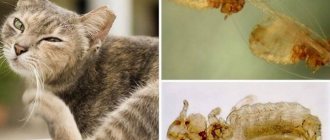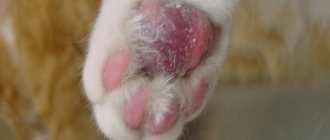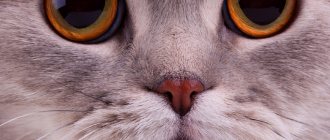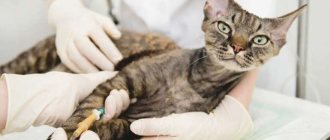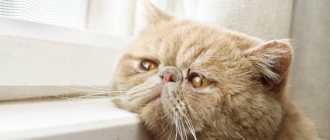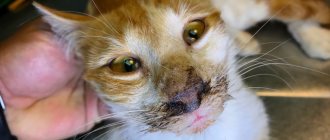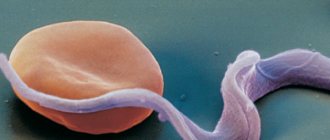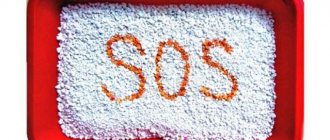Benefits and harms
Alcohol has a detrimental effect on the entire body if you give your cat too much of the drink. First of all, the liver and stomach suffer. Vodka has a diuretic effect on the kidneys, therefore, in addition to toxins, beneficial vitamins and substances are removed from the animal’s body. Alcoholic drinks destroy the walls of blood vessels, disrupt the functioning of the heart, increase arrhythmia and increase blood pressure. Alcohol also has a negative effect on the nervous system and dulls vision.
However, despite all the listed disadvantages of vodka, there are also positive qualities. It has antiseptic and antibacterial properties. Various herbal tinctures, elixirs, balms and rubs are prepared using alcohol. They are used externally internally as a cure for many diseases.
What are useful recipes used for?
For indoor use
If cats are poisoned, give them a solution of vodka. The component is combined with water in a 1:1 ratio and the pet is given 1 tablespoon of the resulting composition. However, vodka is most often used to treat cats from panleukopenia, the so-called distemper. The pathology is a viral infection that can affect all organs within a few days. Manifested by the following symptoms:
- diarrhea;
- vomit;
- cardiopalmus;
- weakness;
- loss of appetite;
- lymph nodes increased in size;
- copious discharge from the visual organs and nose;
- the appearance of purulent wounds on the skin.
There is no known cure for this disease. Animals suffer for a long time and die helplessly in front of their owners. And only if you add alcohol, you can save the cat. You should drink vodka once a day, 1 tsp. Positive results in the well-being of kittens are observed within a day. There is another recipe with an egg:
- Take 20 ml of vodka or 10 ml of diluted alcohol.
- Break the egg and separate the yolk.
- Mix it with liquid.
- Give to kittens or older animals 2 times a day.
Pets drink this mixture much better. After using the product, there is no need to feed the cat fermented milk products for several days, since the yolk neutralizes the toxic properties of alcohol.
Recipe for helminthic infestation
Worms found in kittens can also be treated with vodka. Veterinarians warn: if an animal drinks alcohol, which is very quickly absorbed into the stomach and intestines, parasite poisoning occurs. Give 0.5 tsp. 2 times a day for 3 days. After this time, the cat must be rehabilitated. If the animal drinks milk, it should be given a drink for several days. In case of milk intolerance, as, for example, in a British cat, you can offer some other fermented milk product. As a rule, no trace remains of the disease.
Vodka for external use
Vodka is also successfully used for frostbite. If during severe frosts the kitten's ears, nose, paws or tail are frozen, then you should bring the pet into a warm room and begin treatment. First, you need to wash the affected areas with soap and water and gently wipe with vodka. You can also resort to using moonshine. If the cat has frostbitten limbs, then apply a bandage with cotton wool soaked in alcoholic liquid.
Sometimes your pet can get hurt. First of all, you should stop the bleeding using hydrogen peroxide, and then treat the skin around the wound with vodka. Next you should apply a bandage. If the wound is minor, you can continue to treat it at home. Otherwise, you need to contact a veterinarian who will provide professional assistance.
Is it possible to give a cat vodka?
Traditional medicine recipes successfully treat diseases not only of humans, but also of our pets. If your cat is sick and it is impossible to get to the veterinarian due to certain circumstances, grandma’s recipes can save you. The most famous treatment for cats is vodka.
Effect of ethanol
There is a myth that ethanol is a natural metabolite. It is not true. There is not a single reaction that occurs inside a living organism that would result in the production of ethanol.
At the same time, there are many bacteria in the intestines whose task is to produce vitamins, process fiber, and some of them produce ethanol (about 3 grams per day).
However, there are no such microbes inside the cat’s intestines; they exist only in the gastrointestinal tract of humans and other omnivores and herbivores.
Ethanol is a neurotoxic poison, a carcinogen and a drug that suppresses the activity of the central nervous system. Suppression of the nervous system is possible up to coma and death. The lethal dose is 5-8 ml of alcohol per kilogram of weight, that is, for a cat this is about 3-4 tablespoons of 40% vodka (it contains 20 ml) or teaspoons of pure ethanol.
Stages of intoxication with increasing dose
When consuming small doses, the “reward system” is activated, the active substance of which is dopamine.
The purpose of these reactions is to motivate the animal to perform certain actions: sex, successful hunting, victory over an opponent in a territorial fight.
However, you should not think that you can give your cat alcohol to “relax” it, since the “useful” dose is too small - literally 0.1 ml of ethanol or 0.3 ml of vodka. It is inconvenient to administer such an amount of alcohol even through a syringe.
A further increase in the dose depresses the activity of the central nervous system; every person has seen all these aspects more than once or even experienced it on himself:
- the brain’s ability to concentrate on various thoughts decreases, only one idea remains (usually not a good one);
- coordination of movements is impaired;
- the hunger center is stimulated, that is, the animal’s appetite increases;
- the last stage is narcotic dreamless sleep.
Sobering up
It begins simultaneously with intoxication, but since this process is slow, its result is felt only after stopping drinking alcohol.
Sobering up is directly related to the destruction of ethanol.
It goes in 2 stages:
- Decomposition of ethanol to acetaldehyde . Several systems in the body are responsible for this; the transformation of alcohol occurs both inside cells and in the blood, liver and intercellular fluid.
- Decomposition to acetic acid . This stage of decomposition takes place exclusively inside the cells, which is why the speed of this stage is greatly inhibited.
It is acetaldehyde that is the main cause of all the unpleasant sensations of a hangover. Moreover, the second stage takes much longer than the first. As a result, due to the difference in speed, acetaldehyde accumulates, which is not destroyed immediately, resulting in a hangover.
Treatment with vodka is dangerous for the lives of cats
Cheers to everyone, my dears! Everyone knows about treating animals with vodka, especially against distemper. Let's look at this issue and its feasibility in general.
Vodka is essentially ethanol, ethyl alcohol. Like other alcohols, ethanol is metabolized by the liver under the influence of the enzyme alcohol dehydrogenase. Ethanol is a monohydric alcohol and is a central nervous depressant, on the other hand it is a rich source of calories. Let's consider the indications for the use of ethanol.
Medically, ethanol is administered to treat ethylene glycol (antifreeze) poisoning. In this situation, it acts as a competitive inhibitor of alcohol dehydrogenase, slowing the metabolism of ethylene glycol to toxic metabolites (such as glycoaldehyde, glycolate, glycoxalate and oxalic acid).
Ethanol may also be used to treat methanol poisoning (similar rationale).
Ethylene glycol is very toxic to animals. Just a few milliliters of it are lethal for cats, but for dogs the toxic dose is slightly higher. Ethylene glycol is metabolized to glycolaldehyde and then glycolic acid, which cause serious problems in the body.
Ethanol binds to alcohol dehydrogenase 100 times faster than ethylene glycol. And by making sure ethanol is present in the blood, we can prevent ethylene glycol from being metabolized into more toxic substances. At the same time, ethylene glycol is excreted through the urinary system.
That is, it can take up to 48 hours to rid the body of all the antifreeze, so it is necessary to keep the patient in a “drunk state” for two days in a row. You can also make locks in central intravenous catheters with 70% alcohol.
In medical practice, this method is widely used, especially in patients with intestinal failure who are completely on parenteral nutrition, to reduce infection of central venous catheters.
There is also mention of another attempt to use alcohol for therapeutic purposes - this is the percutaneous injection of ethanol into the thyroid gland of cats with hyperthyroidism (experiments in 2001). Side effects after such a procedure are Horner's syndrome, dysphonia and laryngeal paralysis, death. Therefore, this treatment method is not recommended.
Here, in fact, are all the indications for the use of ethanol (vodka). Firstly, in industrial circles, alcohol is as common as water and even cheaper than dirt. Adding a penny price for an ingredient to a product that could cost many times more is simply a great business strategy.
The second point in favor of using alcohol in oral care sprays for cats and dogs also comes down to cost-effectiveness. Alcohol is, after all, an excellent preservative. By blending your products with the equivalent of 50-year-old cognac, you can produce tens of thousands of bottles at a time, using minimal production costs.
Warehousing costs are cheaper than small-scale production costs. Finished products can be stored in a warehouse, awaiting release to the market for 1 to 5 years, maintaining their “freshness”.
There is the American Society for the Prevention of Cruelty to Animals (ASPCA), which prohibits the consumption of alcohol even in minimal quantities. When a cat is given alcohol, the chemical properties of the blood change very quickly.
Alcoholic ketoacidosis develops, and acute metabolic acidosis may occur. What is simply a hangover for a person can be fatal for a cat or dog.
Cats and dogs also weigh much less than humans, making them more susceptible to the toxic effects of alcohol, including death. But owners often try on dosages that are subjectively small for them.
Alcohol depresses brain function in animals and can even cause coma. The dog lacks the protective enzymes that allow people to drink a certain amount of alcohol without harm to the body.
Symptoms of alcohol intoxication: lethargy, fainting, vomiting, shortness of breath in dogs, cats gasping for air, abdominal pain, dehydration, diarrhea, convulsions, coma, death.
You can, of course, ignore the fact that in the world there are no indications for the use of alcohol for infectious diseases in cats and dogs, that world veterinary associations strictly inform that animals should not be given alcohol, and go against the development of veterinary medicine in Russia.
But I still want to believe that reason will win and we all, who are responsible for the lives of our patients, will follow the scientific and evidence-based principles of medicine, eradicating over time “village” methods of treatment based on the number of years worked in the profession, and not on basis of knowledge.
Click “Like” and receive only the best posts in ↓
Causes of vomiting in cats
The reasons why vomiting in cats can occur can be very different: from the most common overeating, to very accelerated food intake, as well as parasitic and infectious diseases. A common cause of vomiting in cats after eating can be cats eating grass or getting hairballs or hairballs in the stomach, which can irritate it.
If a cat has vomited a couple of times, but no changes are observed in the animal’s behavior, then such vomiting is not very bad and the animal can be given appropriate help. It is important to monitor what food you give your pet. If vomiting occurs too often, for a long time and is not related to nutrition, you should contact a veterinarian, as such vomiting may be a symptom of infectious diseases, liver or kidney disease.
If your cat is vomiting, this may be a symptom of the following diseases:
- Inflammation of the intestines or uterus.
- Panleukopenia.
The appearance of various uncharacteristic impurities in the vomit, for example, blood, bile, various lumps and clots, as well as fecal matter, should alert you greatly and you should immediately seek help from a veterinarian.
Prevention of panleukopenia
Following a number of preventive measures will help prevent your cat from becoming infected:
- Vaccination. This method is the most effective. Poly- or monovalent vaccines are designed to protect the animal from infection. Most often, drugs such as Nobivak, Multifel, Quadrikat are used for this. It is prohibited to vaccinate weakened, sick, pregnant or nursing pets. The category of animals most vulnerable to this type of parvovirus is kittens, so it is recommended to start vaccinating them from 2 months of age. Revaccination is done 3 weeks after the first vaccination. Sexually mature individuals are vaccinated annually. Before vaccination it is necessary to carry out deworming. It is better to carry it out 2 weeks before the vaccine is administered. In order for the offspring to inherit from the mother passive immunity to this disease, which is valid in the first 2 months of the cubs’ life, the cat must be vaccinated before mating.
- Destruction of objects (beds, tray, bowls) with which the infected animal came into contact. If your pet has died from this disease, it is not recommended to get another cat until at least 1 year has passed since the death of the previous one.
- Keeping new pets in quarantine for 2 weeks.
- Feeding a balanced diet. The animal's diet should consist of meat, fish, dairy products, vegetables, and herbs. If your cat's diet consists of ready-made food, it is recommended to choose only high-quality brands.
- Regular use of vitamin and mineral complexes to maintain the animal’s immunity at the proper level. It is recommended to coordinate vitamins with your veterinarian.
- Isolating a pet with panleukopenia from other pets.
- Regular preventive veterinary examinations. It is recommended to do this at least once a year. This measure will allow timely identification and elimination of the symptoms of a dangerous disease.
- If pathologies are identified, immediately begin to eliminate them.
- Avoid contact between your pet and stray animals while walking outside.
Share with friends!
Vomiting blood
The vomit may contain scarlet blood or blood the color of coffee grounds. The presence of scarlet blood in the vomit is a sign of damage to the esophagus, pharynx, and the possible presence of small wounds in the oral cavity. It is necessary to carefully examine the cat's oral cavity for the presence of wounds or foreign objects. Well, if there is a brown admixture in the vomit, this indicates that bleeding is occurring in the stomach and under the influence of gastric juice, the blood changes its color. Bleeding in the stomach can be caused by foreign objects entering the stomach, the occurrence of tumors, gastritis, and so on. In this particular case, it is also necessary to seek help from a veterinarian.
The causative agent of the disease
Canine distemper in dogs is caused by a virus from the paramyxovirus family (contains RNA). This pathogen is extremely close in its structure and characteristics to the virus that causes measles in humans. And it is also similar to the causative agent of plague in large (and, of course, small) livestock
Therefore, it is very important to take precautions when interacting with sick or even recovered animals.
The pathogen is extremely stable. Unless it dies instantly in boiling water, so be sure to disinfect items caring for a sick pet (bowls, toys) in this way. Even after complete recovery (when there are clinical signs of distemper in dogs), a virus remains in the blood that can cause the disease. Therefore, the animal can infect other pets. Even nasal discharge contains a dangerous microorganism. But urine and feces pose a greater danger.
Vomiting in a pregnant cat
In most cases, it occurs in the morning, and the cause of occurrence is the same as in pregnant women and is explained by toxicosis. If this happens two or three times in the morning, and the vomit does not contain foreign impurities, there is no cause for concern. If this all happens not in the morning, but throughout the day and there are some uncharacteristic impurities, then take the cat and go to the veterinary clinic.
With severe and repeated vomiting, the animal’s body becomes dehydrated due to the loss of a large amount of fluid. And if diarrhea is added to this, then dehydration of the cat’s body occurs much faster, so you need to be more careful.
How does the virus work?
After the distemper virus enters the cat’s body, it spreads throughout the body through the lymph. Afterwards, absolutely every system of the animal’s body is affected – digestive, nervous, bone marrow and others.
In an adult cat, the first symptoms appear seven days after infection. However, in a small kitten, whose body is smaller and whose immune system is weaker, the first signs are noted two days after infection.
Try to carefully observe the behavior of your pet predator. Any change in behavior can lead to big problems. As soon as you notice something strange, go to the vet immediately.
Ways to treat vomiting in cats
The food and water must be removed first, as this will only further irritate the stomach. If a cat vomits once, with suspicion of overeating, then it is necessary to refrain from feeding for five to eight hours. Water can be given only in small quantities; there is no need to force the cat to drink. If your appetite begins to appear, this is a good sign. But you shouldn’t rush to give your cat a full bowl of food right away. Food should be given in small portions so as not to cause much harm to the gastrointestinal tract. It is much better in small quantities, but often.
At-risk groups
Kittens under one year of age are especially susceptible to the disease. They have the weakest immune system. Cats between one and six years of age are the hardiest, as this is the peak of maturity. But after six years, the cat begins to age and its biological defense decreases. Also, a pregnant animal is at risk. Its protection, in connection with raising offspring, is not as good as that of an animal at the peak of its activity.
Animals under one year old and over six years old are most susceptible to the disease. Keep a close eye on your pet, get your cat vaccinated against distemper and visit your veterinarian regularly.
What to give your cat for vomiting
For the first couple of days, it is better to follow a gentle diet with boiled rice, boiled lean chicken, or special medicinal foods. It is necessary to switch from a diet to a usual diet gradually, this should be constantly remembered. You need to gradually add regular food to your diet; this should be done until the ratio of regular food to dietary food becomes maximum.
Folk remedy against vomiting:
A decoction of chamomile and flax seeds has a very good effect on the gastric mucosa, which should be given three to four times a day, 1-4 tablespoons, depending on the size of the cat.
Primary signs of plague
Many inexperienced dog lovers are wondering how to identify distemper in a dog at its very early stages?
This is explained by the fact that the primary signs are not expressed particularly clearly.
The most characteristic early symptoms of the onset of the disease are:
- Slight lethargy of the pet, depression.
- Decreased appetite, occasional vomiting.
- Redness of the mucous membranes of the eyes.
- Discharge in the form of mucus from the eyes, nose. In general, distemper disease in dogs - the symptoms of which are indicated - is a very dangerous disease.
- Mild dyspeptic disorders.
- The majority of dogs have a tousled coat.
- Photophobia appears, which manifests itself in the fact that the animal avoids the bright rays of the sun and regularly hides in corners.
All of the above symptoms have varying degrees of severity. In the first 2 days, the pet’s body temperature increases to almost 40 degrees Celsius and lasts for about 3 days.
Many dog lovers are interested in whether they treated the dog’s distemper and it all started all over again. This is explained by the fact that adults are able to cope with this disease on their own, and the existing signs are reversed. However, over time, and also if the pet’s immunity is weakened, the animal may get sick again. Puppies and weakened pets will continue to get sick with a permanent deterioration in health.
Drugs
If the attack of vomiting recurs and becomes severe, then you can give an intramuscular injection of Noshpu, Cerucal at the rate of 0.1 milliliters per kilogram of the cat’s weight. In addition, you can give sorbents Atoxil and Enterosgel. In case of severe vomiting, giving electrolyte solutions like Regidron is ineffective. In case of repeated or severe attacks of vomiting, you must immediately contact a veterinarian, otherwise self-medication can lead to very bad results. The doctor will be able to determine the degree of dehydration of the body, will be able to put in an IV and determine the cause of vomiting.
